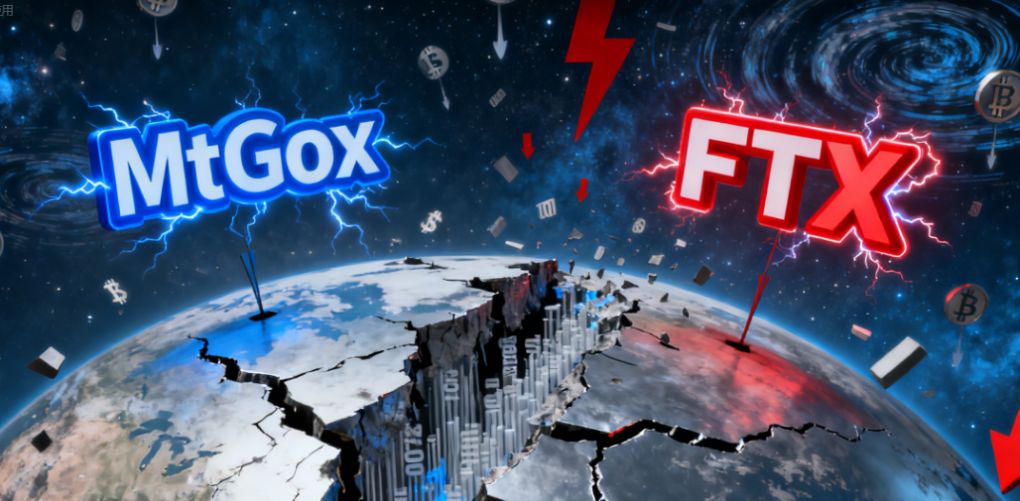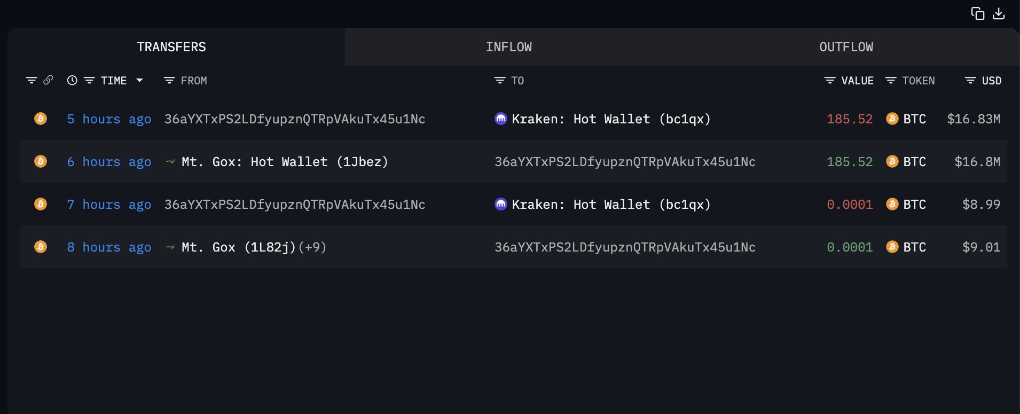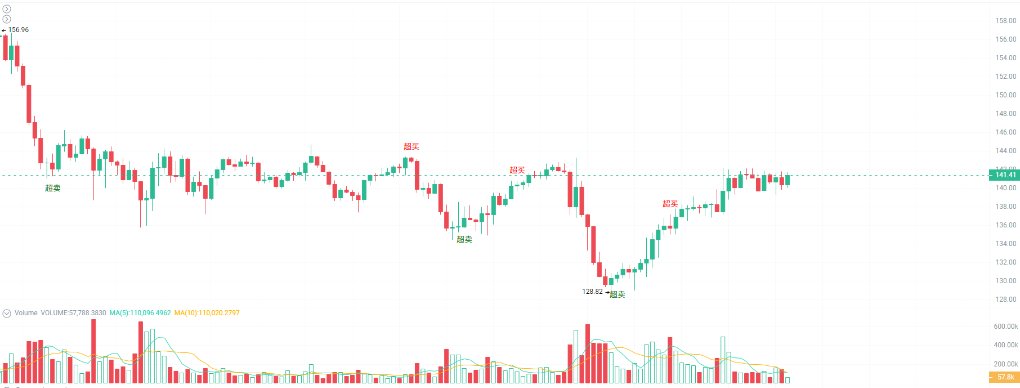Over $1 billion worth of bitcoin and altcoins are awakening from the wallets of two once-dominant exchanges, signaling the start of a major asset transfer that could reshape the market landscape.
In the past week, the crypto world witnessed the most notable asset movement in two years: the long-dormant Mt. Gox wallet suddenly transferred approximately $956 million worth of bitcoin after eight months of inactivity.
Meanwhile, FTX/Alameda-related addresses have also been unusually active, moving millions of dollars’ worth of various tokens to exchanges and custodians, suspected to be in preparation for creditor repayments.
Though these two events are worlds apart, they both point to a single fact: the two longest-running bankruptcy cases in crypto history are quietly entering a critical phase of asset return.

I. Mt. Gox: The Awakening of a Sleeping Giant
● On the night of November 18 (GMT+8), the Mt. Gox address suddenly transferred 10,608 BTC, valued at about $956 million at the time. The funds were split into two parts: around 10,422 BTC were sent to an unmarked address “1ANkD…ojwyt”, while about 185.5 BTC were moved to Mt. Gox’s own hot wallet.
● This move broke an eight-month silence for the address. Blockchain intelligence platform Arkham confirmed the transfer, but Mt. Gox’s motives and the final destination of the bitcoin remain unclear. However, similar transactions in the past have typically signaled the start of repayments to creditors by the now-defunct exchange.


The Long Road to Repayment
● The Mt. Gox saga began in 2010. This Tokyo-based exchange once became the world’s largest bitcoin exchange, handling 70% of global bitcoin transactions in 2013.
● However, a hack in early 2014 led to the loss of about 850,000 BTC, forcing the company to file for bankruptcy protection.
● In July 2024, Mt. Gox will begin repaying creditors from its holdings of 142,000 BTC (worth $11 billion), 143,000 bitcoin cash (BCH) (worth $47 million), and 6.9 billion yen ($469 million).
● The repayment process has been full of twists and turns. On October 27 this year, Mt. Gox’s rehabilitation trustee announced another one-year extension of the creditor repayment deadline to October 2026—the third extension from the original deadline of October 31, 2023.
II. FTX and Alameda: Multi-Chain Asset Transfers
As Mt. Gox’s bitcoin began to move, FTX and Alameda were also conducting a series of complex asset transfers.
● According to on-chain analyst @ai_9684xtpa, FTX/Alameda recently transferred 190,837 redeemed SOL (worth about $34.06 million) to the Bitgo custody platform. Sources say these funds will be used to compensate FTX creditors. Analysts point out that if these assets are liquidated, SOL could face short-term selling pressure and liquidity shock risks.
● This is not the only recent move by FTX/Alameda. According to Spot On Chain, FTX and Alameda transferred $10.8 million worth of 8 assets to Wintermute, Binance, and Coinbase in the past 11 hours.
● These assets include 10 million GMT ($2.58 million), 407,000 UNI ($2.41 million), 5.23 million SYN ($2.25 million), and several other tokens.

III. Market Impact and Potential Risks
The large-scale asset transfers by Mt. Gox and FTX/Alameda have raised concerns about potential selling pressure in the market.
● If we apply the historical data where about 64.1% of funds were transferred to centralized exchanges to Mt. Gox’s remaining balance, in the worst-case scenario, about 22,253 bitcoin could simultaneously enter exchanges, with potential selling pressure of around $2.4 billion.
● However, the same report notes that Kraken and Bitstamp have processing windows of up to 90 days and 60 days, respectively, so actual settlements will be staggered in batches. There is also the possibility of using custody or OTC (over-the-counter) channels to avoid the order book, thereby reducing direct market impact.
● Galaxy’s Head of Research, Alex Thorn, has also stated that the bitcoin selling pressure triggered by Mt. Gox will be less than expected.
SOL Faces a Test
● For the FTX/Alameda asset transfers, traders are advised to closely monitor whether the Bitgo custody address subsequently transfers assets to exchanges, as well as changes in SOL spot liquidity and order book depth, to gauge the potential distribution pace. In the 24 hours prior to the news, SOL’s price fluctuated between $140 and $150, with trading volume on major exchanges surging by about 15%.

● Analysts believe that while this transfer may exert downward pressure on SOL in the short term, it also demonstrates the crypto market’s maturity in compensating creditors through structured processes, which could foster greater investor confidence over time.
IV. Historical Burdens and Industry Maturity
The asset movements of Mt. Gox and FTX are not only about short-term market fluctuations but also reflect the crypto industry’s progress in dealing with legacy issues.
● The Mt. Gox rehabilitation process has become one of the longest bankruptcy cases in crypto history. From the bankruptcy filing in 2014 to the first repayments in 2024, creditors have waited a full decade.
● The collapse of FTX and the subsequent asset recovery and liquidation process showcase the crypto industry’s increasingly mature mechanisms for handling large institutional failures.
Both cases show that even after the most severe crises, it is still possible to recover a significant portion of assets through legal procedures and blockchain transparency.
Differences in Repayment Strategies
Mt. Gox and FTX have adopted different approaches in their repayment strategies. These differences reflect the two exchanges’ distinct asset structures and bankruptcy management styles, and have influenced market reactions to the two events.
● Mt. Gox mainly distributes crypto assets through designated exchanges (such as Kraken and Bitstamp);
● FTX/Alameda, on the other hand, uses a decentralized approach across multiple chains, assets, and platforms, including direct transfers to exchanges, use of custodial services, and OTC trading, among other channels.
V. Future Outlook and Challenges
As Mt. Gox and FTX/Alameda’s asset disposal enters a critical stage, creditors are finally seeing hope for compensation, but the market may face a new round of challenges.
● After the latest transfer, Mt. Gox’s trust wallet still holds about 34,689 BTC (worth about $3.1 billion). How these assets are handled will be a key factor influencing the future bitcoin market.
● FTX/Alameda’s asset handling is also far from over. On-chain analyst Ember’s monitoring shows that since November 2023, FTX/Alameda staking addresses have redeemed and transferred a total of 8.98 million SOL (about $1.202 billion), with 4.184 million SOL (about $960 million) still staked.
● These large-scale asset transfers are happening against the backdrop of a significant crypto market rebound, especially as Ethereum prices reach new multi-month highs. At the same time, regulators are paying increasing attention to such asset disposals.
● Future crypto exchange bankruptcy cases may draw lessons from the Mt. Gox and FTX processes, establishing more standardized and transparent creditor compensation mechanisms, including: safer asset custody, clearer asset records, and more efficient distribution methods.